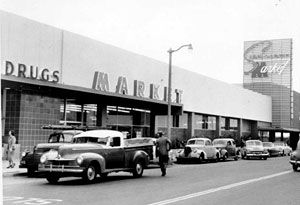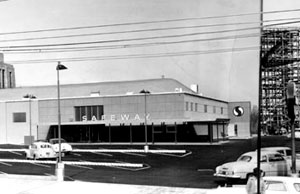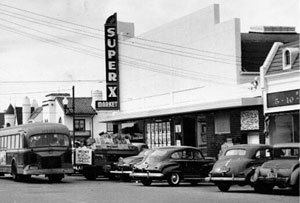The 1950s

Stonestown Market (SF Library).
The 1950s: era of the classic supermarket, postwar suburbanization, etc. Of course, San Francisco is an anomaly with respect to many urban development issues in the latter part of the twentieth century. First, San Francisco is unlike other California cities in that it is dense and compact in more of an east coast pattern.
In addition, San Francisco never really suffered the depopulation and decay which similar cities saw from the 1950s through the 1970s. Essentially, there was always a middle-class here, even though there was some level of suburbanization as well. Much of that suburbanization was, though, still contained in outlying districts within the city limits. The 1950s brought the peak demand for such areas as the Outer Sunset and Outer Mission districts, and also brought something San Francisco had not yet seen: shopping centers like Stonestown, Lakeshore, and Laurel Heights.
Unlike many other California cities, San Francisco was largely “finished” in the 1950s, with most of its area already developed and with no room to expand. Most further development, whether retail or residential would now start to replace something that had already been there.
Safeway had 35 stores in San Francisco in 1951; 21 of these survived until 1960. In addition, 11 new locations opened during the period, leaving the total at 32 as the 1960s began. By this time, Safeway was by far the dominant grocery retailer in San Francisco.
Several older stores still remained in operation during the 1950s, the oldest being a location in the Outer Mission (301 Rolph Street) which was built in the late 1920s and lasted through the late 1950s. This store was, however, an exception, and newer stores with parking and large floor areas were becoming the norm.
Of course, the inner city may not have been the idea place for Safeway to construct its classic 1950s box, which may explain why the early 1950s was not a significant time for new store construction. Some, however, were built between 1951 and 1955, including a large store at Turk and Fillmore in the Western Addition (now a police station), and others on Fell Street near the Panhandle and on Alemany near the Daly City border (both demolished).

Safeway, 2020 Market Street, 1954 (SF Chronicle).
Also, on 5 May 1954, the chain’s flagship store at 2020 Market opened to much fanfare. Wity mezzanine and basement, this branch featured almost 40,000 square feet of floor area, and was the largest store in the company at the time. It was also the site of a 3200 square foot test store where Safeway experimented with non-food items. A decade later, this would be the site of one of Safeway’s first “Super S” drug and discount stores.
The late 1950s saw considerably more construction, with new stores all over the city. On 24 June 1959, the new store at 15 Marina Boulevard, opened a new chapter in Safeway store design as the first of its large glass arch stores (later known as “Marina” stores due to the location of this branch). The 21,000 square foot branch featured murals by local artist John Garth, and such modern conveniences as “a machine that wieghs (meat) and automatically produces a sticker with the correct price”m a rotisserie, and a full-time home economist.
In addition, the new store at 30th and Noriega became a prototype store based on its “sophisticated” use of color, including straw yellow, pine frost, and tile blue.

Super X, 24th and Noriega (SF Library).
Littleman Stores continued to thrive during the 1950s. While its total number of stores dropped from fourteen to eight, this was largely due to consolidation resulting from the large supermarkets being built. Notable examples which still have supermarket tenants include the stores at 4201 18th Street in the Castro District and 6333 Geary Street in the Outer Richmond District.
In addition, Littleman operated stores formerly owned by independents or chains, including a former Safeway on Polk Street and the former Gene’s Foods on Ocean Avenue.

Former Cala Foods, 201 Leland Street.
Cala Foods was also beginning to grow, having picked up several larger locations, including a classic streamline modern store from the late 1930s at Geary and Stanyan. QFI stores was also a big player with many co-branded stores, including the Sunset Super, Lick Super, and the Stonestown Market, in the large new Stonestown Shopping Center.
Lucky Stores also got into the supermarket game about 1954 with the construction of a new store and an entire shopping center, Lakeshore Plaza at Sloat and Sunset. This would continue to be Lucky’s only store in the city for several years, although the chain was growing rapidly outside San Francisco.
The 1950s were not so kind to Purity Strores, Great Western-Wissman, and Embee, all of which had largely disappeared from San Francisco by the end of the 1950s.

I would like to see my grandfather’s grocery store chain (10 stores, 2 warehouses) QFI- Quality Foods Incorporated located in San Francisco and the Bay Area in your article. Calisto Musso was an Italian immigrant from Milan.
Thanks,
Louis
What was the name of the store on the corner of Third St and Paul Ave across from B &J’s burgers
I would like to learn about Filing & Ingram Grocery which opened in 1905 at 22 nd Ave and California St. The name changed to Appel & Dietrich Fine Foods when my father Henry Appel snd Clifford Dietrich took over in 1953.
The MacMarr grocery store at 444 Taraval street. was purchased by my father (Ben Hom, 1960-80s) and became New Checker market (named for the store front tiles). Was a family run neighborhood business. My mother (Sue) and brother (David) and sisters (Ginger, Jeannie) and myself (Richard) worked there. There were 4 gas stations on the corners, hardware store and cleaners as well. It was a busy block with people stopping for gas and picking up groceries on their way home after work. Was replaced by a mixed use residential apartment building and store front in 1987.